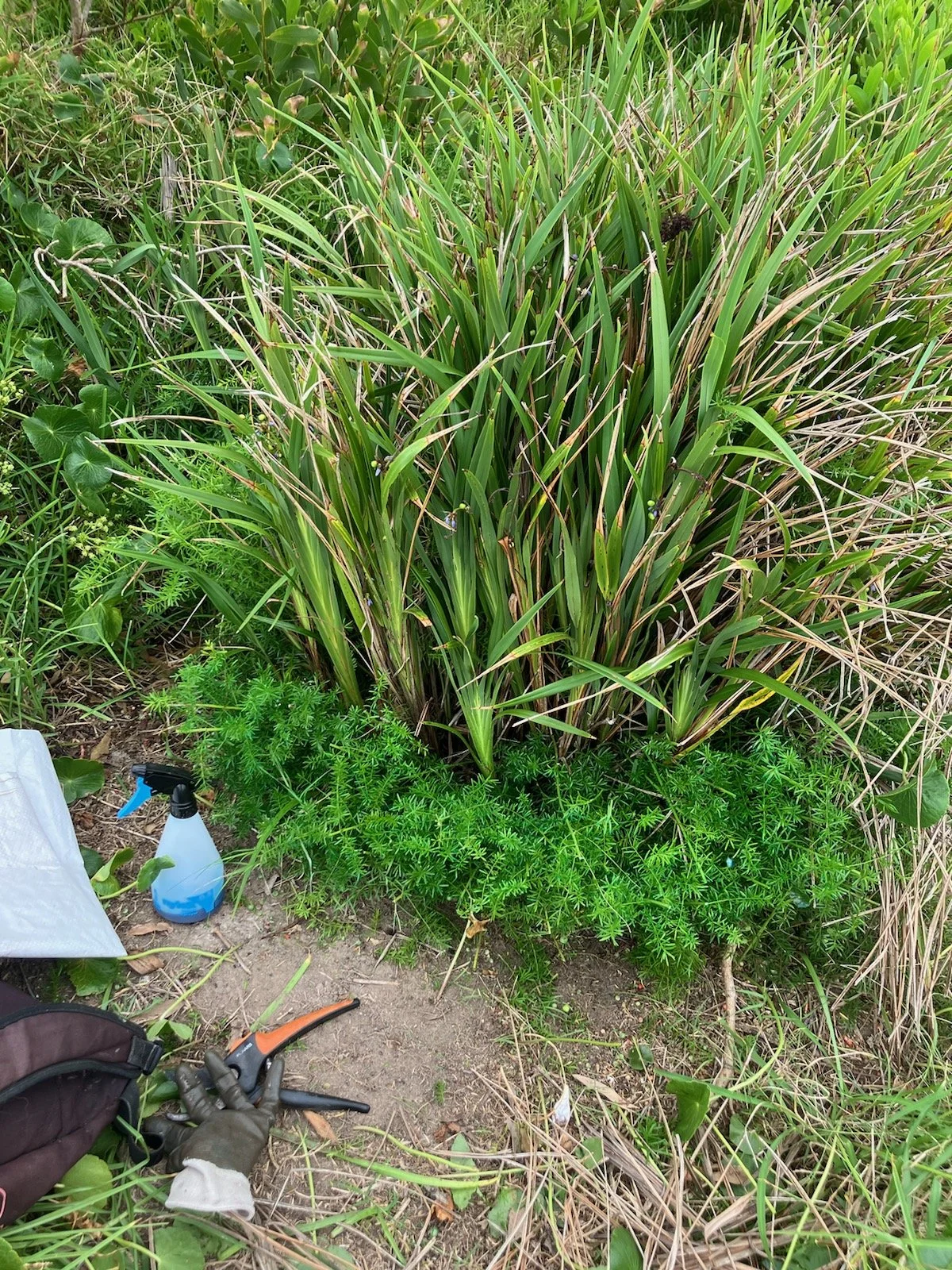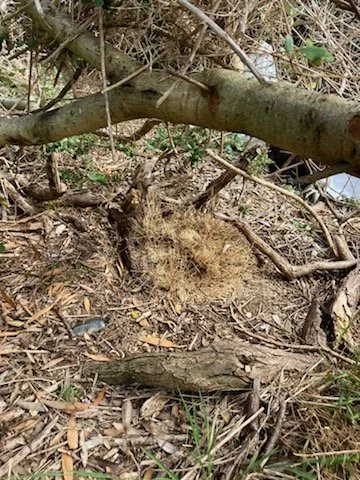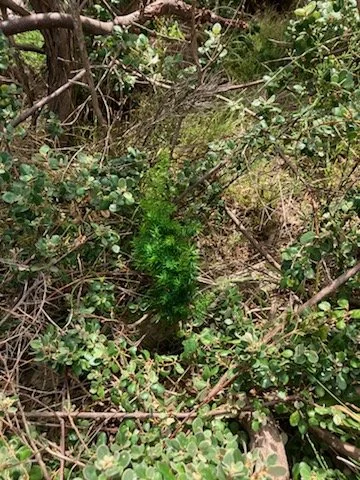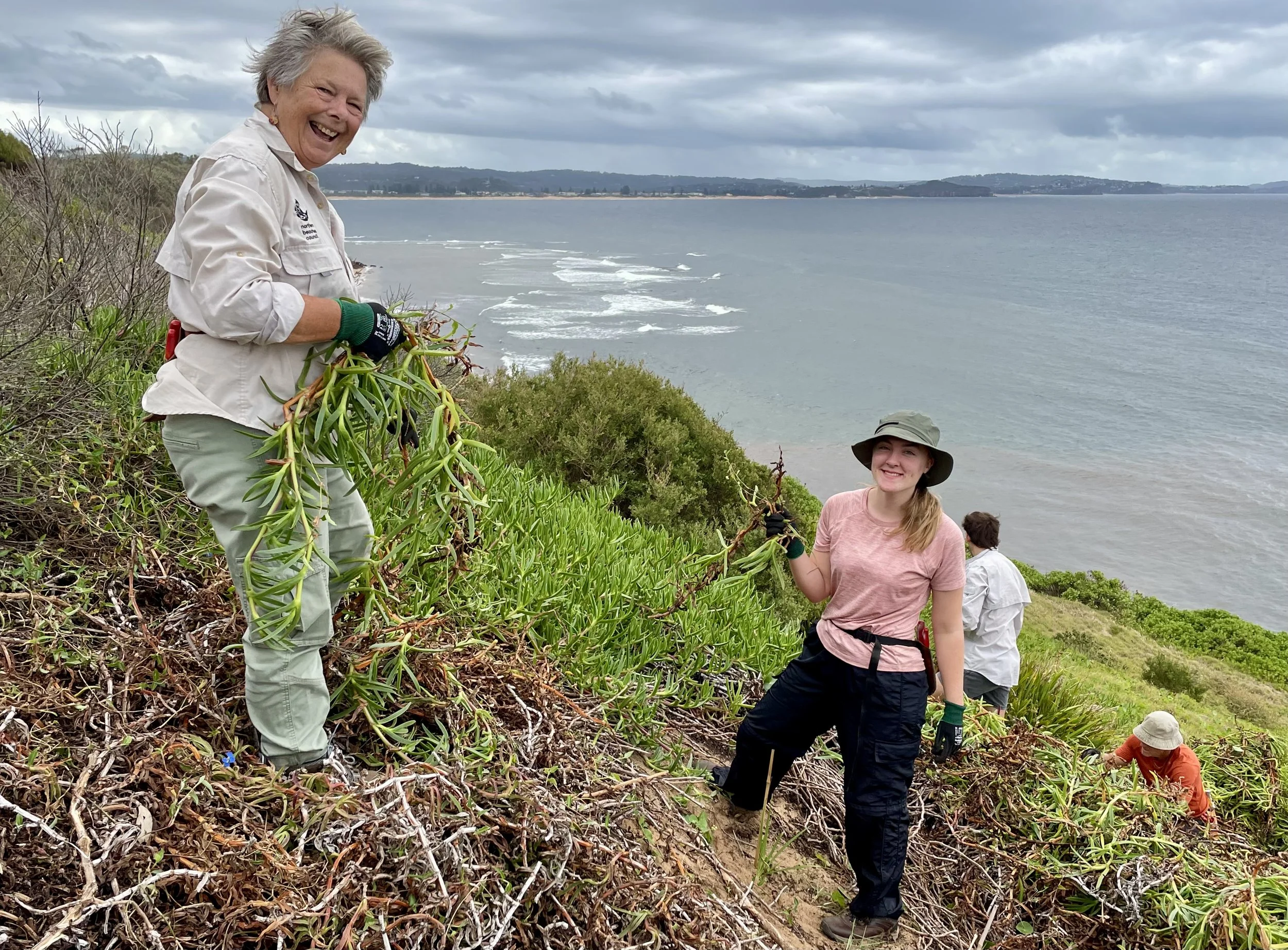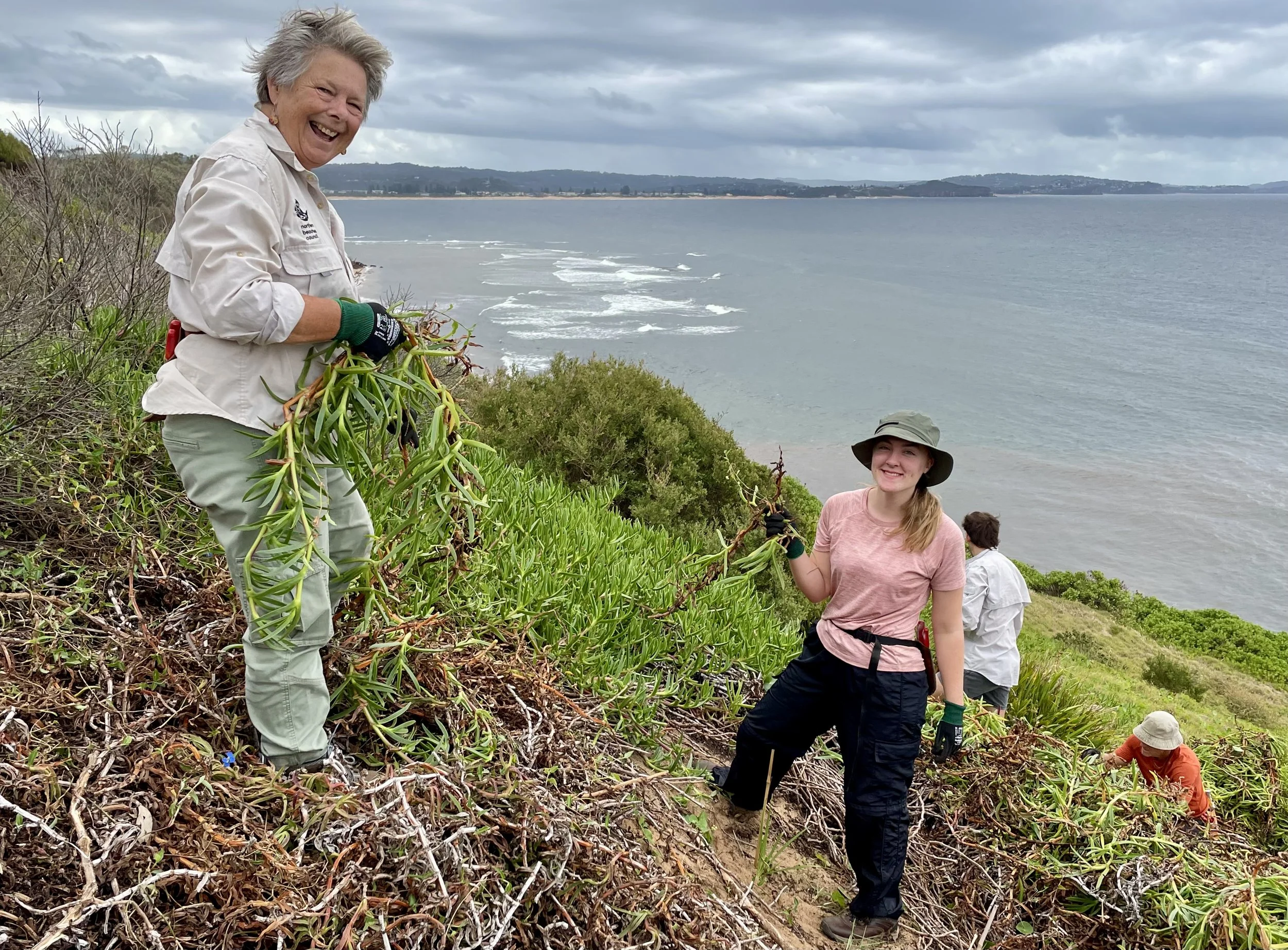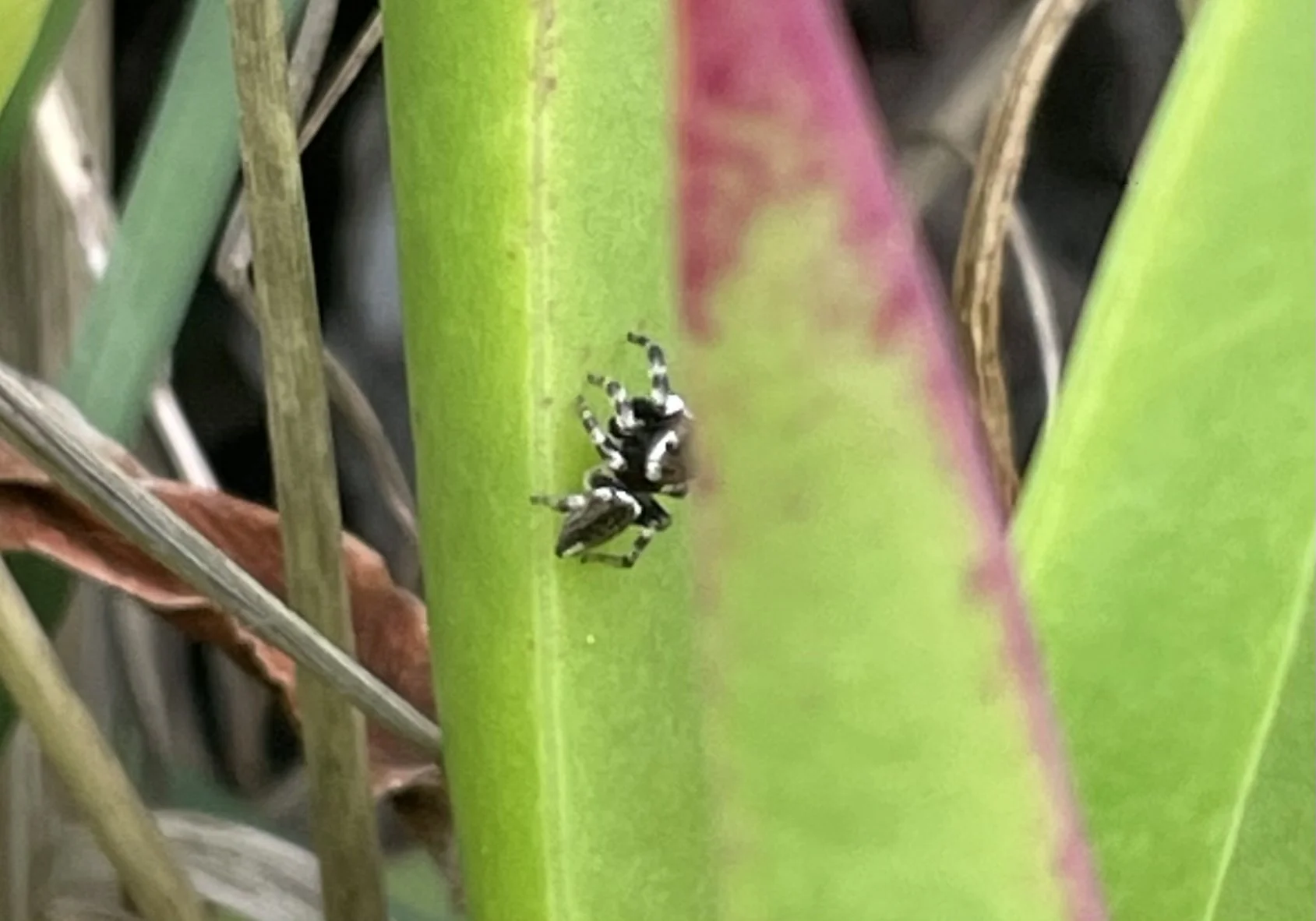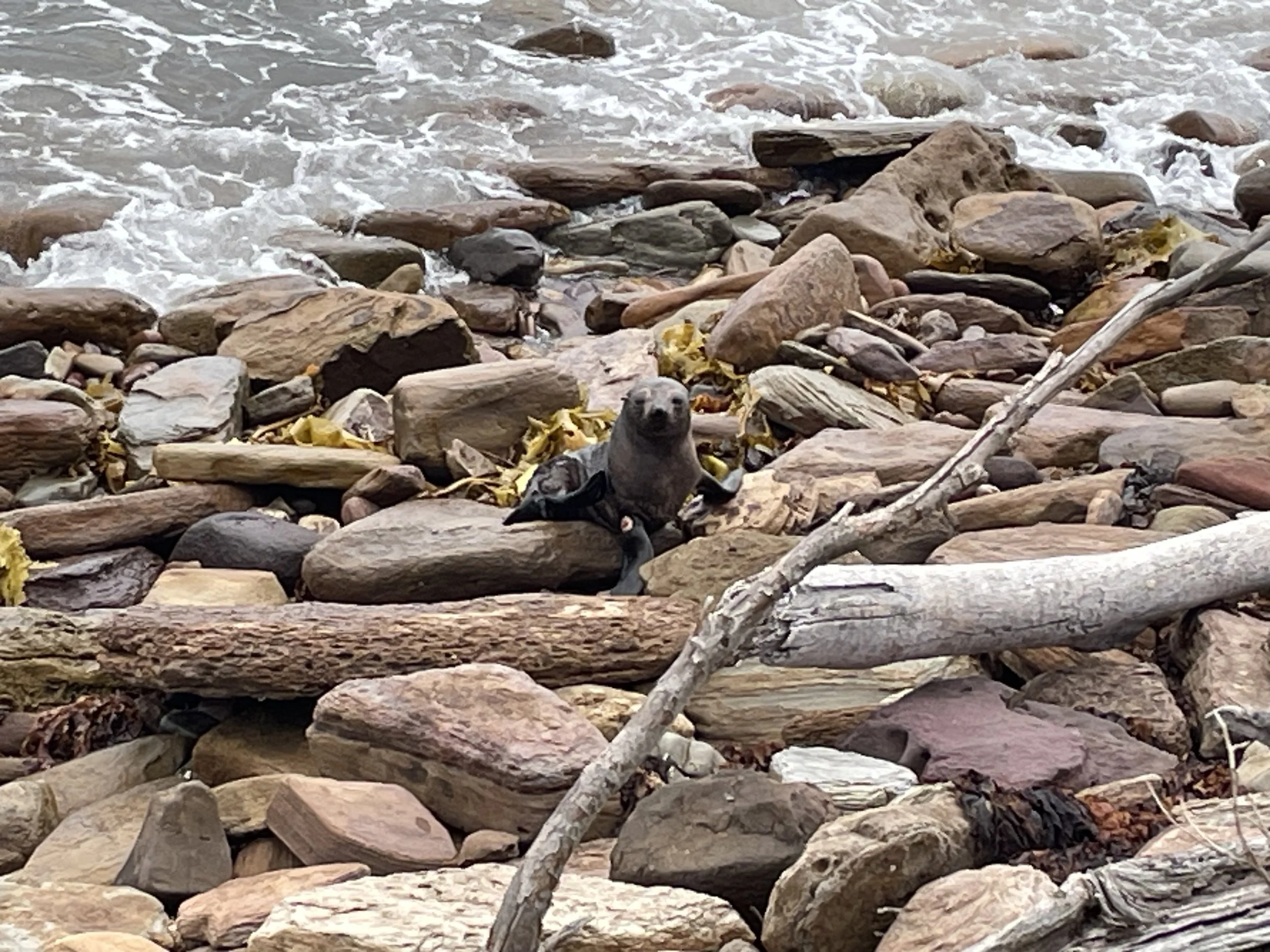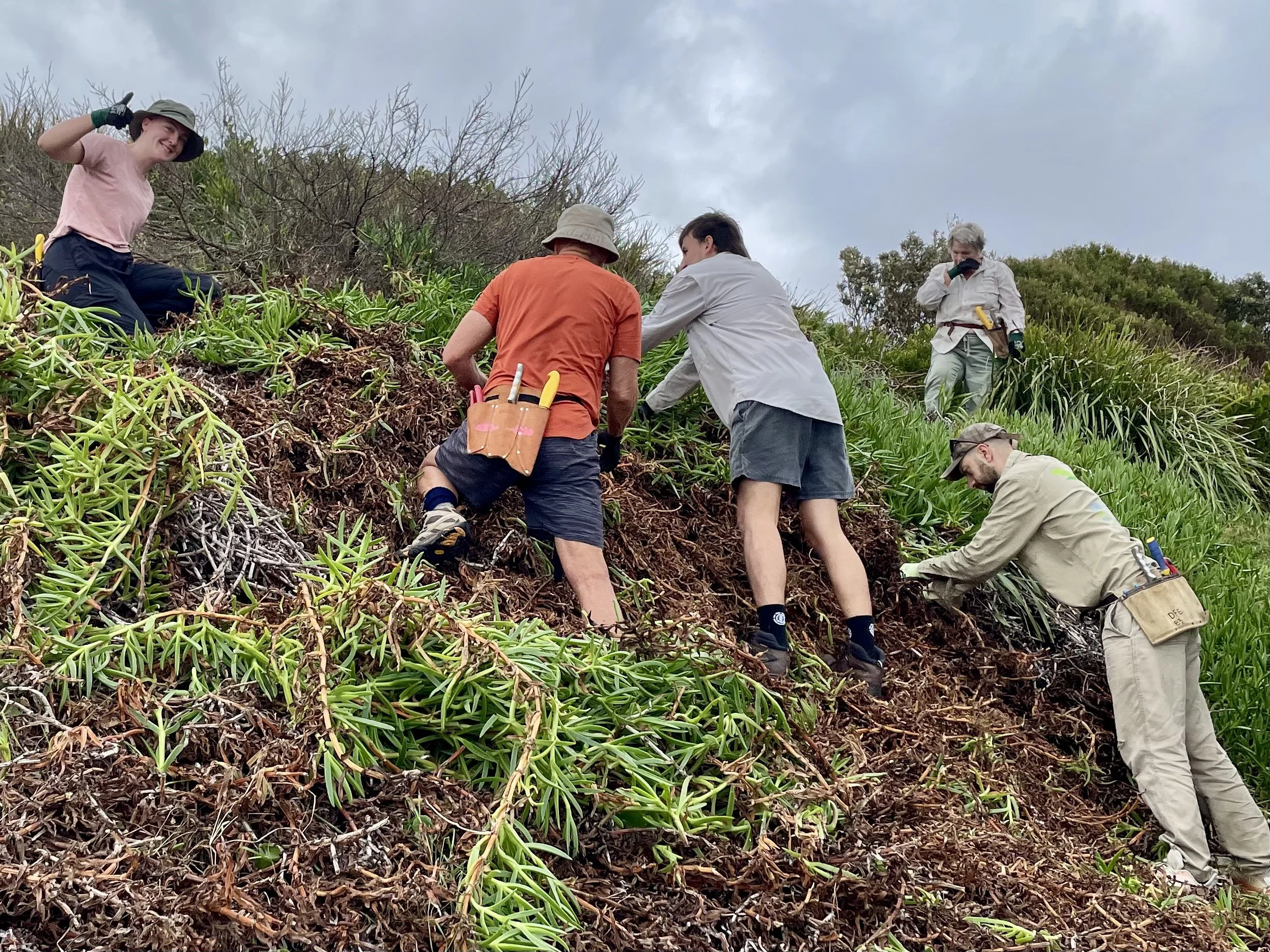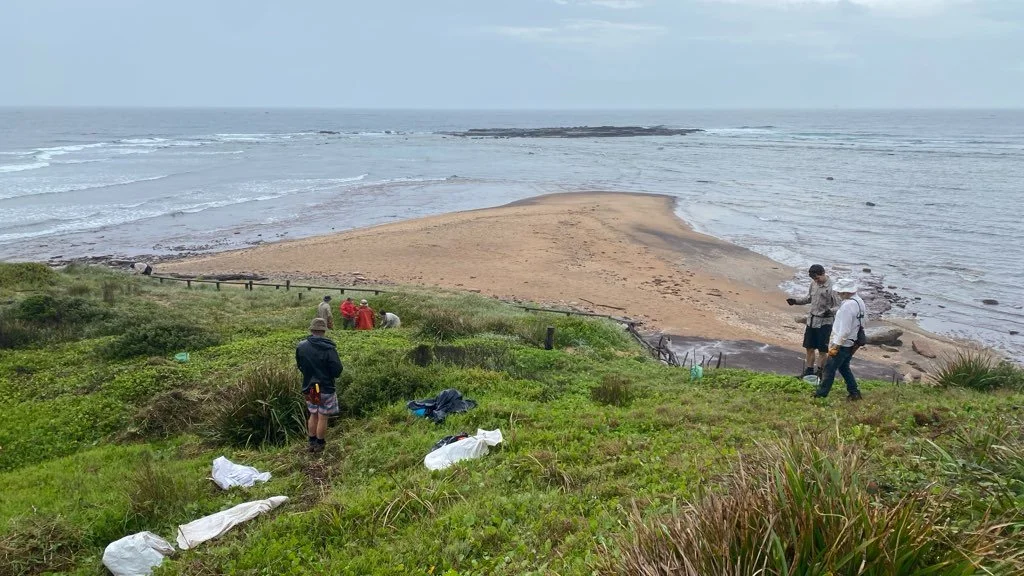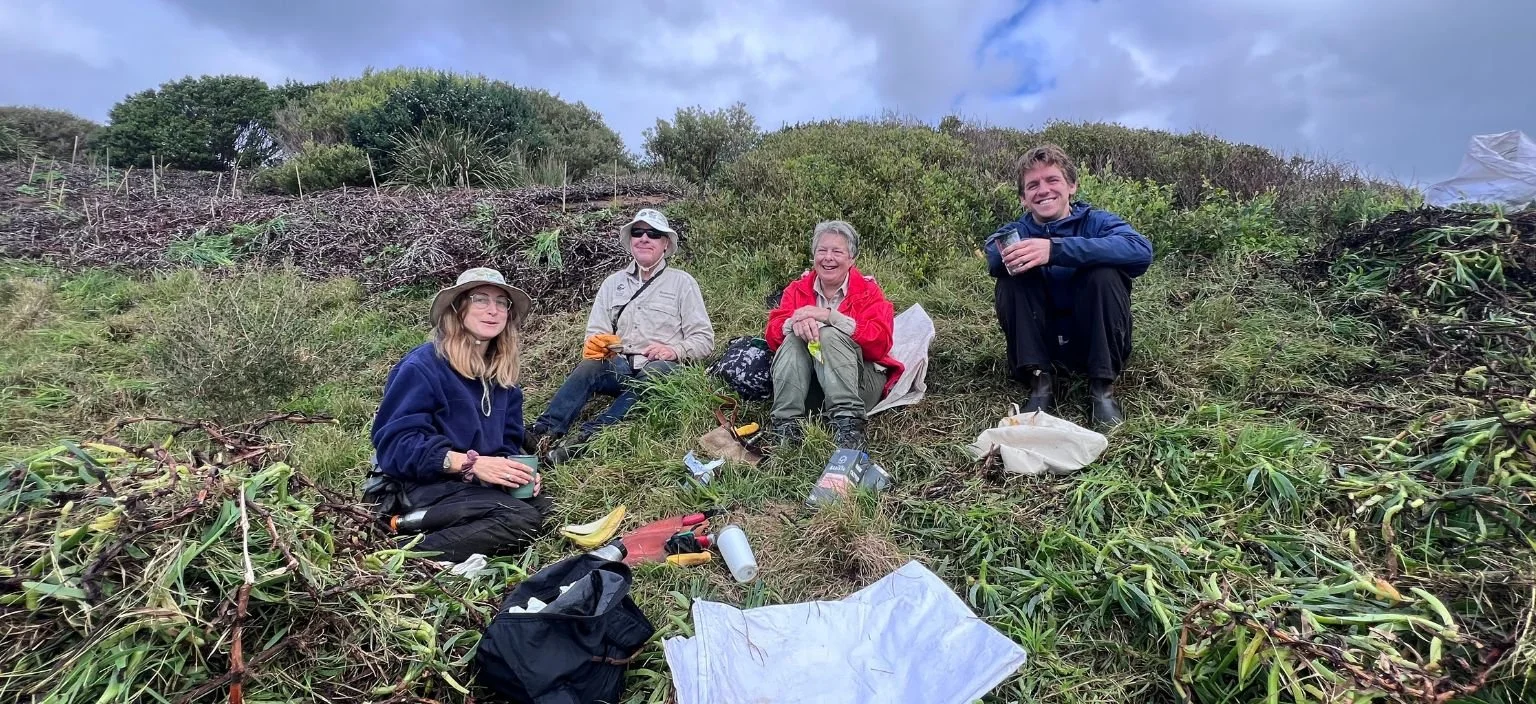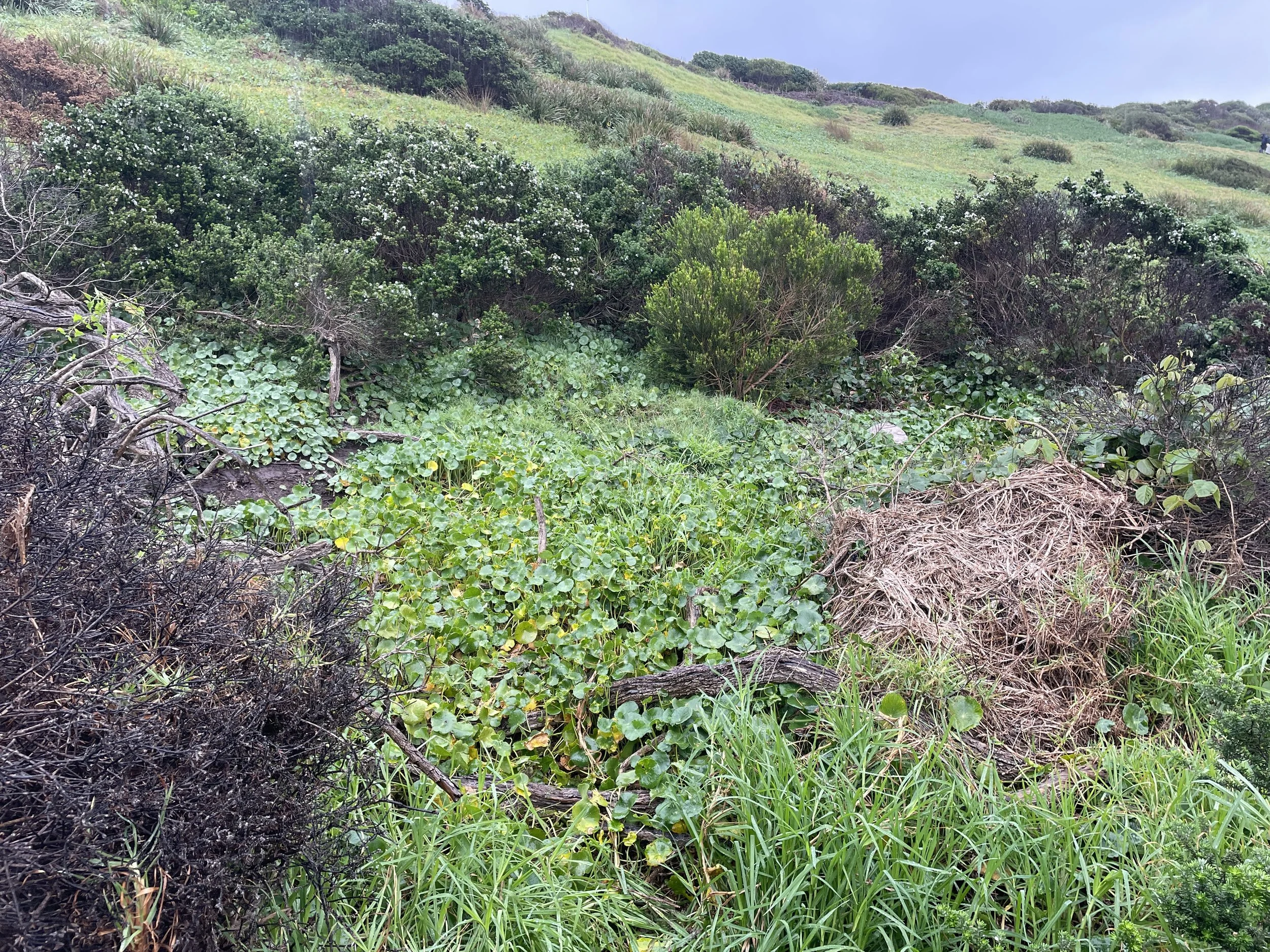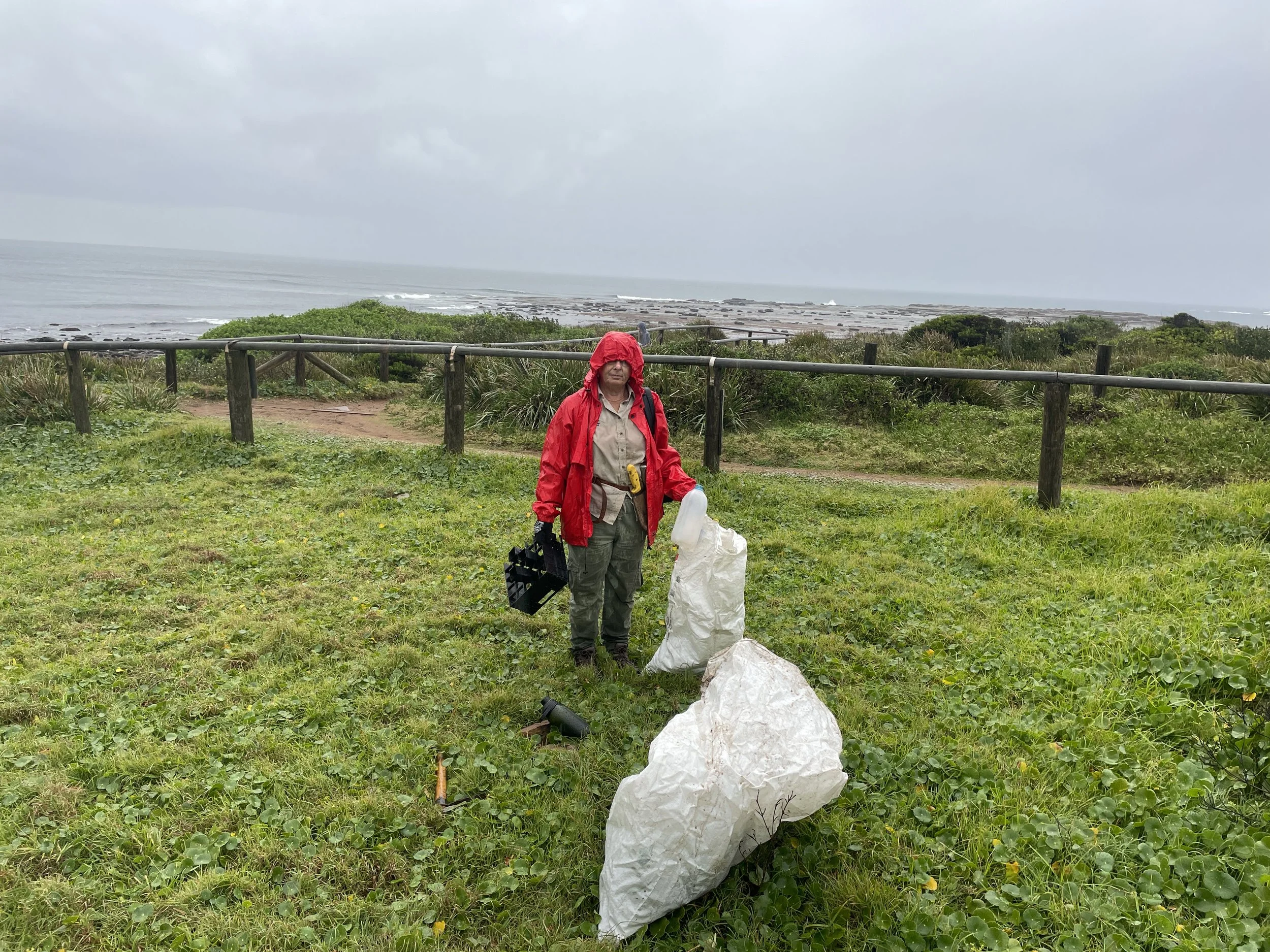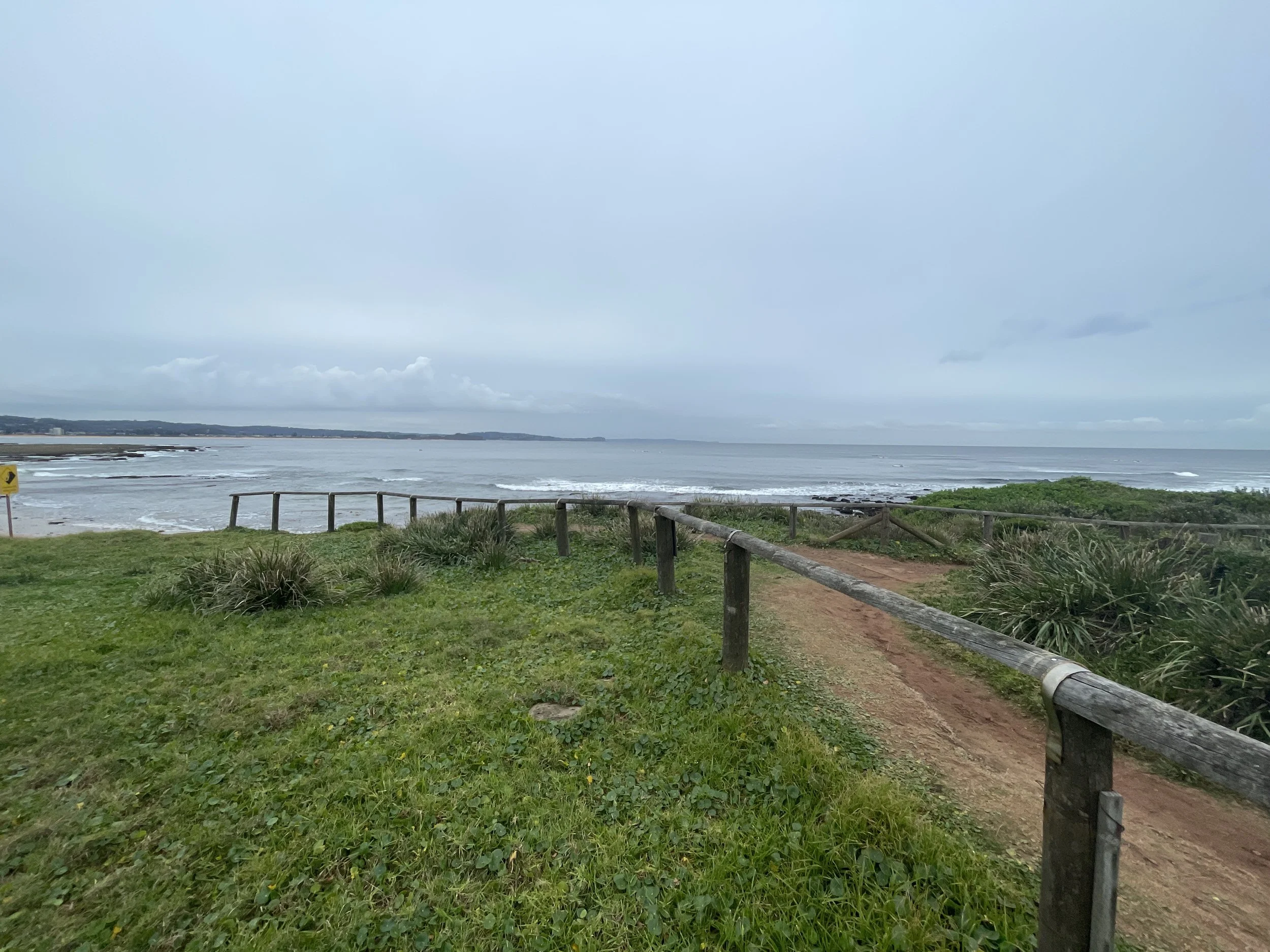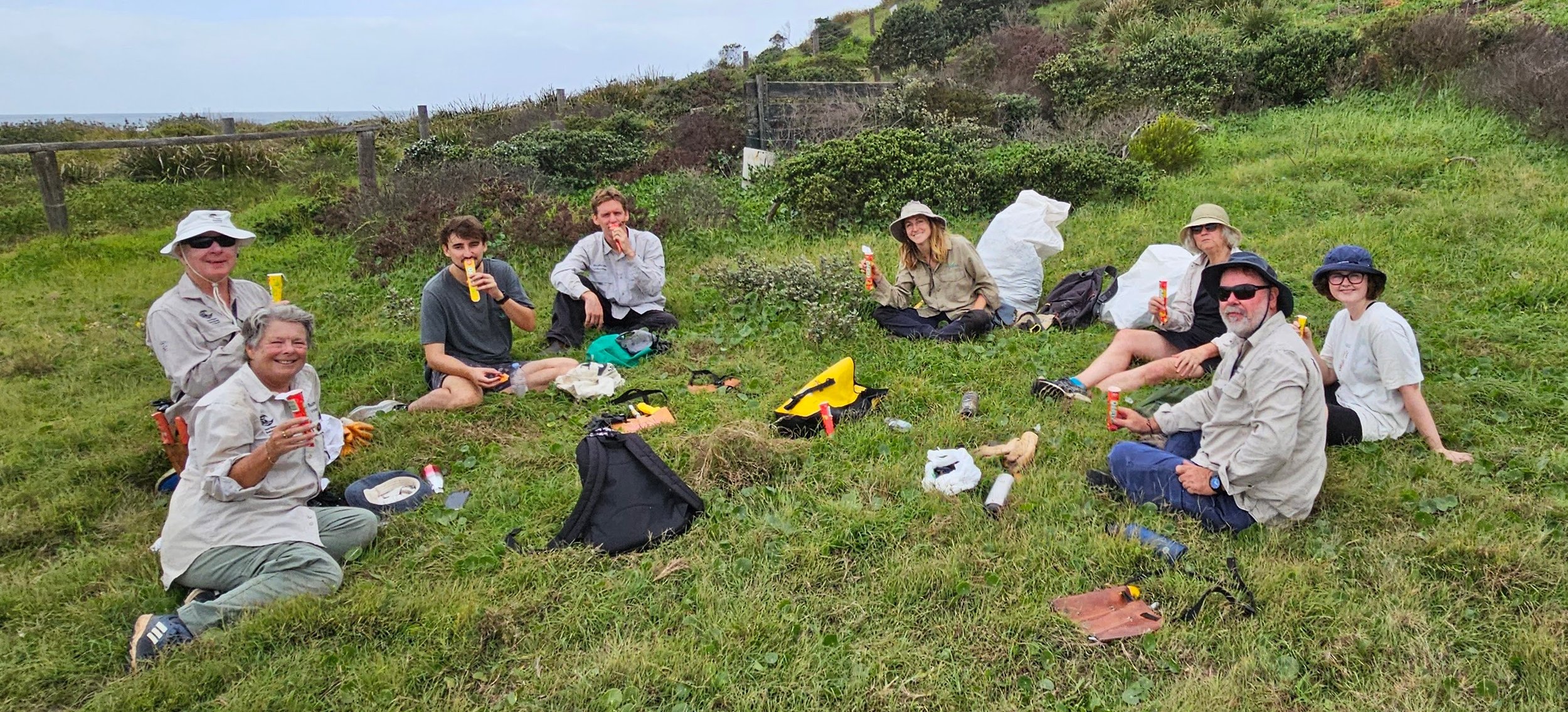
Blog
Reefcare Day Report: A day of planting new seedlings
On a warm but overcast morning, twelve keen volunteers gathered at the carpark, with 50 seedlings to set free into the wilds of Long Reef …
Stephanie and Karina prepare the ground to plant some tube stock
On a warm but overcast morning, twelve keen volunteers gathered at the Long Reef carpark. With fifty seedlings, lots of tools, bottles of water and twelve people, it took some organising to work out how to best target the two planting areas we wanted to tackle.
Once out onto the site, Lisa, Stefanie, Karina, Bec and Elias planted seedlings around the Lomandra longifolia on the northern dune, before joining Brad and Gen on the high western slope. Here, they planted the balance of the tube stock around the gully and the western side of cleared Bitou. The sandy soils here required them to build terraces with old bitou branches. The ground preparations are vital to encourage any rainfall to stay in the tube stock area.
Correa alba, taken out of the tube and ready for planting. We have never seen wombats on our site but they would like these. Photo by Stephanie.
Here is hoping we have some rain in the next three to four days; otherwise, Des and Lisa will be struggling down the slopes with 8+ litres of water each, to help our newly planted seedlings get established in the sandy soil.
While Brad and Gen were planting the stock, they also collected some of the lush and lovely Commelina cyanea, to transplant around the more western part of the site. The extra ground cover should help prevent erosion of the sandy soil, until the newly planted natives get established.
Julie’s focus was the top area below the whale sculpture where the asparagus fern is growing through the thick grass, dianella clumps and acacia/ correa scrub. Where the asparagus fern is enmeshed in and ringing the dianella, she removed seed, pruned it back and then sprayed with blue dyed glyphosate.
Julie sprays glyphosate on the asparagus fern that has encircled the daniella plant. We usually do not like to use glyphosate, but in this case, removing the plants manually would cause major damage to the daniella. Photo be Julie.
Dead asparagus fern. Photo by Julie
This type of work in ongoing. Last month Julie re-sprayed two large crowns of asparagus fern which had regrown thickly. This time, both crowns are dead, but will need to be checked again next month. Clearly, they are resilient !!
Julie is aiming to find the best method of asparagus fern eradication which requires low energy by volunteers, but has high impact on the plant.
Bright green asparagus fern. Photo by Julie.
Julie advises that removal of the seeds by running a gloved hand along the stem means less weight to carry off the site. Making a 'ponytail' bunch of the Asparagus Fern stems means spraying is focussed and not wasted.
Canavalia Rosea mature pod with a few seed pods still in situ. It is great to watch the lifecycle of these plants, from pink flowers, to big green seed pods and now ready to set seed again. Photo by Stefanie.
In addition to planting the seedlings, we still needed to keep the weeds at bay, so Julie, Merrilyn and Des worked on asparagus fern and Bitou around the site. This is a constant source of work as there are hundreds of these sprouting up, especially with the asparagus fern seeds being dropped by birds. Once Alex moved to the high slop area, Mary who has to be careful of her ankle worked on asparagus fern.
Morning tea below the old bundles of pigs face, with a view over the ocean. Photo by Lisa.
Alex and Mary worked on turkey rhubarb removal. Alex found more sites of turkey rhubarb to eradicate, which was very upsetting news as we thought we just had a few sites to monitor. From past experience, we know that any infested area needs to be monitored for months to years as dormant seedlings suddenly burst into life. We suspect that the seeds are being blown in from the infested Long Reef dunes, south of our site.
After the planting was finished many of the group worked on ridding the gully of the non-native pigs face. This weed would otherwise smother our earlier plantings. With Brad, Gen, Lisa, Elias, Stefanie, Karina, Alex, Bec and Denise working together, they managed to clear a good-size area. We will need a follow up next month, but I surmise it won’t take long, and we can move onto the eastern slope of the gully, to join it up with the larger cleared area from last year.
Elias shows how to build terraces on the steep sandy slope, before planting Westringia fruticosa tube stock. Photo by Stephanie.
We bundled the non-native pigs face into piles. These flatten down as they dry out, providing good ground cover on the steep sandy slopes. Photo by Lisa.
In the afternoon, as we left the site and passed the area we worked on last year, we were thrilled to see the plantings had thrived. The space looked vibrant and healthy. We may be able to add more plants here, perhaps a task for next month.
Text by Lisa.
Reefcare Day Report: A big turnout for the start of 2025!
What a fabulous start to 2025 with thirteen Reefcare volunteers turning up! Once again it was exciting to see so much wildlife as we worked …
It is all smiles as Lisa and Stefanie clear Pigs face on the upper slopes near the Gully.
What a fabulous start to 2025 with thirteen Reefcare volunteers turning up! It was a mild, cloudy 20 degree day, so perfect for working on the open terrain. After signing on and allocating equipment, we took some photos of Merrilyn and Des, each with a plant donated by the Northern Beaches Council (NBC) for their attendance – follow the link below for more details and photos.
Once again it was exciting to see so much wildlife as we worked. A nankeen kestrel hovered over us as we weeded, looking for prey, and an osprey soared over the slopes, a small fish in its talons for morning tea. On the ground, Brad found a baby eastern blue tongue (Tiliqua scincoides) and soon after, Des found another one. It felt so rewarding to see that this native animal is breeding on our site, the native vegetation providing good cover from the weather and predators.
we found another maroubra snail and Kristie found a spider, not seen at Long Reef before, which looked like it was from the Salticidae family. As the Long Reef area returns to native vegetation the number of insects and invertebrates is increasing. Lisa recalls seeing almost no insects when she started clearing the invasive bitou bush, twenty-seven years ago!
This jumping spider: Maratus scutulatus (white garland house hopper) was seen hunting in the foliage at Long Reef. Photos and video by Kriste King.
We were having a relaxing morning tea on the upper slopes when Stefanie spotted an Australian fur seal (Arctocephalus pusillus doriferus) near shore. It came up onto the beach where Brad and Kristie saw that it was hurt, so they called the sea life rescue organisation: ORRCA. They arrived at about 1 pm and set up signs to warn people of its presence. They had been monitoring it since yesterday. NPWS set up a 40m exclusion zone so it can rest while recuperating from its injuries. The Northern Beaches Council also posted some photos of it on their Facebook page and website:
Seals occasionally come ashore at Long Reef. This one was injured so we called the sea life rescue organization: ORRCA.
After morning tea, Des spent his time scouring the site for small bitou seedlings, asparagus fern, and other weeds to try and maintain our better areas as best we can. He was backed up by Merrilyn, who focussed on Gladiolus caryophyllaceous, as well as asparagus fern and bitou seedings which proliferate all along the north-facing slope of our site. Julie spent all her time on asparagus fern, as she had done for the last half of 2024. This weed is severely problematic on our site. There are huge plants along the fence line, in the public areas around our site and in the dunes just south of our site. Birds pick up the seeds elsewhere depositing them all over Long Reef.
Alex and Leila continued to work on the turkey rhubarb (Acetosa sagittata) that had infiltrated the acacia, and found dozens of good-sized bulbs. This area has been a focus for the past four working days, and still needs more work. They then checked the nest and another turkey rhubarb source in the Westringina on the flat, before heading back up hill and clearing the rest of the pigs face (Carpobrotus sp) near the fence line.
Elias, Josh, Arthur, Lisa and Stefanie worked on the non-native pigs face and were really thrilled to finally cut through to the gully. In one area where they removed the pigs face they were absolutely delighted to find a large patch of healthy kangaroo grass (Themeda Triandra). They also found a rather freshly eaten large blue tongue. The smell of it encouraged us to work faster and move further west!
Stefanie, Arthur, Josh, Lisa and Elias (our Dragonfly supervisor), clearing pigs face on the upper slopes
Mary is still getting over a twisted ankle and was unable to work on the steep western slope, so she kept to the eastern dunes area, clearing kikuyu on the southern edge of our demarcation. This line was established in our December working day, to protect our beautiful kangaroo grass.
Brad and Gen with some help from Des continued to remove bitou from the western side of our site; as well as Brad and Des cutting a new pathway through the bitou to an area of huge asparagus ferns. It is a steep area involving climbing over roots so hard work for the boys.
It was a great start to 2025 and we are looking forward to our next working day on the 1st of March.
Text by Lisa Calder
Reefcare Day Report: A cool rainy morning won’t stop the fun!
At some point a competition started as to who can pull up the longest Kikuyu runner…..
It was a grey, overcast morning as we arrived on site, to be greeted by a rain shower. We all donned our coats, which never came off as the rain showers kept coming in all morning, one after the other. So much for the forecast of 32C and sun/cloud. We had low/mid 20’s and rain on and off the whole time. Still, it was great to be out in nature with our cozy little group.
However, some were less impressed with the weather than others …
Working on the eastern dunes. Photo by Kathy Shields.
In the photo above, Arthur is facing away from the camera. He was working on getting rid of the kikuyu from an area of Lomandra and tea tree (Leptospermum laevigatum). Along the line of white weed bags you can see the start of the new demarcation line going east to west to stop the kikuyu heading up the slope into a beautiful area of native Themeda. On the right, Alex and Des talk logistics – this is the area where Alex was removing the non native pigs face.
As there was no wind we worked in the south eastern area of the site for a change. Brad and his brother Peter who was out from Colorado, USA eliminated a large Bitou bush and then cleaned up this area of the non-native pigs face, before heading to the northern part of this site to get rid of another couple of bitou – and then helped rid central area of this site of the non-native pig’s face.
Des and Arthur worked on the north/south demarcation line which is there to stop the non-native pigs face going over the bump into the kikuyu and the stopping the kikuyu of getting any further into our beautiful eastern dune area. They cleared kikuyu westward and Arthur did an amazing job getting this rotten grass out of a lovely clump of native plants of Lomandras and a tea tree. Merrilyn worked on one of her two most hated weeds, Gladiolus caryophyllaceous hybrid – (the other is asparagus fern) – she even brought along a sieve to capture the small bulbs at the bottom of the plant from a trowel full of sand. Now that is serious dedication and determination!
Using a sieve is an effective way to capture the small bulbs. Details like this make a huge impact in preventing the return of these weeds.
Merrilyn on the eastern dunes.
Alex and Leila worked on the Turkey Rhubarb which is well into the Westringia and hard to get to, but with a saw (this one is dying so no problem sawing it up!), they were able to get in and were really surprised how many bulbs they were able to find in that area. They also checked the nest, then joined the rest of the team over the other side of the track where Alex removed the non-native pigs face on the southern side, whilst Leila, Lisa (after working on the new demarcation line), Brad and Peter removed non-native pigs face from the central area of the eastern dunes.
Kathy, Ivana and Lisa created a new demarcation line going east to west along the southern slope of the eastern dune area. This line is to stop the kikuyu from the flat area of the eastern dunes moving into our beautiful Themeda grassland, which it is just starting to do. Aim is to continue to work above the line to make sure we get all the kikuyu out of there… and one day hopefully, we can attack the kikuyu in the flat.
At some point a competition started as to who can pull up the longest Kikuyu runner. You be the judge, but it looks like there is no end to the “lengths” we will go to in order to have fun and win :)
We didn’t stop for morning tea as no point just sitting in the rain, so we worked through until 11:15 and then left the site sopping wet. Kathy, Des, Lisa, Alex and Leila met up for a coffee where we chatted about Reefcare and life generally. Alex and Leila also leant about the old days when one could steam an envelope open – their jaws just dropped, so funny.
Text by Lisa, photos by Kathy and Lisa
Reefcare Day Report: Tackling the Turkey Rhubarb
After a past week of rain, wind and cold weather we had a beautiful sunny Saturday upon which our aim was to target more of the non-native pigs face
After a past week of rain, wind and cold weather we had a beautiful sunny Saturday upon which our aim was to target more of the non-native pigs face in which we made a huge difference last month. Unfortunately, we were thwarted constantly on this goal, with finding more sites of Turkey Rhubarb which was all seeding; thus this became our number one priority.
Lisa and Denise planted 10 Westringa on the flat where many of these plants have died having reached their life span – it took 2 hours, as we kept finding more Turkey Rhubarb and there was a lot of Kikuyu which needed to be removed. We met the others on the top of the slope for morning tea and then Lisa removed the rest of the non-native pigs face in the area she didn’t quite finish last month and then the rest of the time working on the Turkey Rhubarb in the Acacia bushes – a continuing effort which Alex, Brad and Gen have already spent a lot of time; it’s a bad infestation.
Alex worked on Turkey Rhubarb on the flat before moving up the slope and removing more where he worked last month and then went on to help removing non-native pigs face and then asparagus fern with Julie and Merrilyn.
Julie, Merrilyn and Kathy spent their whole time on removing Asparagus fern, together with Brad and Gen, much of it we think is out of our area of responsibility, but as the Council/Contractrors are not doing anything about the Asparagus fern in their area, and it is causing issues in our area, we have to spend time doing this for future benefit to reduce occurrences of Asparagus fern on our site, as the Asparagus fern in their area are huge and full of berries.
Maria arrived at morning tea and then she and Denise worked on removing more of the non-native pigs face on the western slope.
Reefcare Day Report: Bushcare wildlife encounters
When the five of us arrived on site at the western slope with 20 plants and a goal to remove more of the non-native pigs face we were serenaded by a delightful singing juvenile magpie who seemed to enjoy having us all around her …
When our team of five arrived at the western slope armed with 20 plants and a mission to clear out more non-native pigs face, we were greeted by the melodious song of a juvenile magpie. Several other juveniles joined in, a heartening sight given the declining numbers of magpies along the east coast.
Magpies, known for their intelligence and complex social behaviors, often delight with their vocal prowess, echoing through the bushland as we began our conservation efforts.
Des and Alex immediately began tackling a patch of Bidens Pilosa, followed by the discovery of Turkey Rhubarb further east—recent invaders from the dunes behind Long Reef.
Meanwhile, Denise captured a colorful hairy caterpillar on camera, noting its vibrant hues and recognising it as a species known for its camouflage ability against local flora.
Lisa uncovered a puffball fungus previously unseen by others. She squeezed it gently, causing dust-like spores to spurt out—a fascinating sight captured on film by Denise, adding to our documentation of local biodiversity.
Julie focused on removing Asparagus Fern atop the slope, hoping to coordinate efforts with NBC's contractor to combat this persistent weed.
As we worked westward, pulling up non-native pigs face, Alex made a significant find: a large amount of Turkey Rhubarb entwined with Acacia roots, a species known for its rapid spread and ecological impact in coastal areas.
Lisa and Alex collaborated to collect seeds and bulbs before rain interrupted briefly at 10 am. Undeterred, we pressed on, uncovering unexpected grass beneath the pigs face, potentially native couch. Further back, Kikuyu grass posed a future challenge, noted for follow-up with Jock from NBC.
Morning tea on the slope provided a scenic break, although whale sightings were absent.
However, we were visited by a charming native rat with light grey fur, a species likely native to the area and indicative of the healthy biodiversity our conservation efforts support.
Kathy's subsequent discovery of signs suggesting native marsupials in the vicinity added to the excitement, highlighting the potential habitat richness of Long Reef.
Later, Lisa's find of live snails sparked intrigue, prompting detailed photos for identification, a step towards better understanding the diverse ecosystem thriving amidst our restoration efforts.
At day's end, Alex delighted a juvenile magpie with a worm, revealing their clever and curious nature.
Despite Kathy's encounter with a tick, treated promptly with Lyclear, the day concluded on a high note with remarkable wildlife encounters. Reflecting on our efforts, the transformation of this site—once dominated by invasive Bitou Bush—now supports thriving wildlife, a testament to Reefcare's impact.
Denise's ongoing work to update Reefcare's website promises to showcase our discoveries at Long Reef, underscoring the importance of our conservation efforts.
Reefcare Day Report: Weeding in the rain
Five of us met at the carpark in very inclement weather together with our Dragonfly Supervisor for the day …
Five of us met at the carpark in very inclement weather together with our Dragonfly Supervisor for the day, Paul; plus 25 plants to get in the ground before the rain really came in – which we expected around 11:00am.
Julie continued up the top removing more Asparagus Fern whilst Des and Brad headed to the high western slope where previous non-native pigs face has been removed to plant 18 of the plants to add to previous plantings over the last few months. They then moved to the western area of the site cutting bitou and throwing onto previous cleared ground so that it can break down and be used for future mulch on site and cover exposed sand to keep moisture in and prevent any possible erosion.
Bitou bush that was poisoned in last month's bushcare session is dying, but the native plants (Myoporum) are thriving! Great outcome!
Alex with mattock and weed bag in hand, headed back to the nest area as unfortunately more turkey rhubarb has appeared within a number of black berry nightshade (Solanum nigrum) with green berries which have appeared on mass in this area as well as Hydrocotyl (Hydrocotyle ranunculoides) - which is also growing all around the site like it’s been fed steroids. Paul worked on the turkey rhubarb on the flat and other general site weeding, whilst Lisa headed to the eastern dunes to plant Lomandra along the tracks where the surfers are cutting through the Reefcare site of good Themeda, and general weeding – Burr Medic coming up but not yet burrs appearing – early for this weed, as it is usually around August.
Return to the nest: some minor turkey rhubarb plants were observed in the nest, some of which were seeding. These were promptly removed and bagged.
Turkey Rhubarb bagged and disposed of.
The rain started lightly sometime after 10:00am, but we put on rain jackets and kept working until 10:30 when it started to get heavier and looked like it was set in – so after meeting Maria in the carpark – great timing Maria! Des, Julie, Lisa and Maria when to a coffee shop and sat around a heater they had to dry out – whilst Paul our Dragonfly Supervisor decided to complete the Green Link walk around Long Reef, as he had not been in this area before – good on you Paul, hope you got back in time before it poured down about 11:15am!
Drowned rats Lisa & Alex working in the rain just before the session was canned.
We leave the site in peace as the rain comes in.




